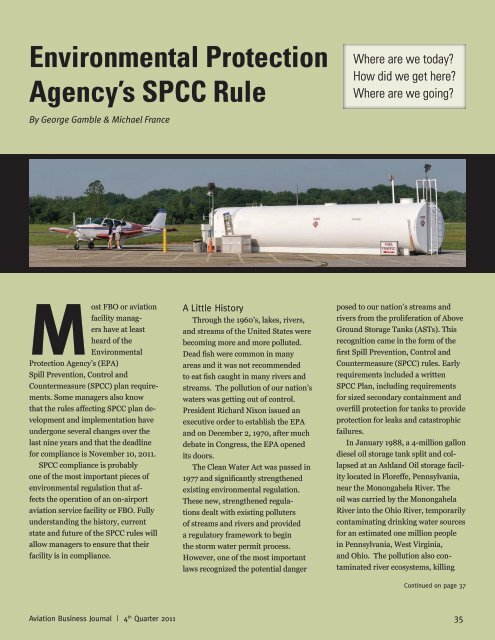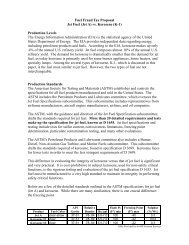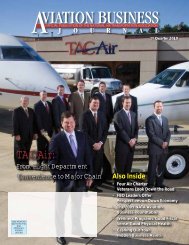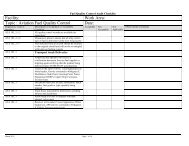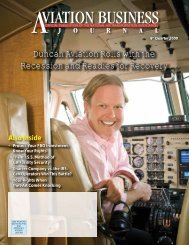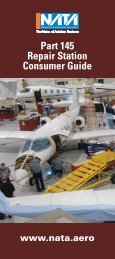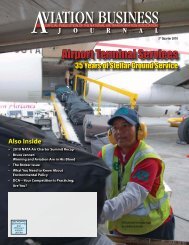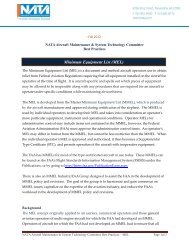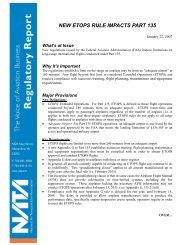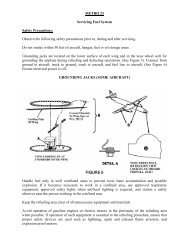Environmental Protection Agency's SPCC Rule - NATA
Environmental Protection Agency's SPCC Rule - NATA
Environmental Protection Agency's SPCC Rule - NATA
- No tags were found...
Create successful ePaper yourself
Turn your PDF publications into a flip-book with our unique Google optimized e-Paper software.
<strong>Environmental</strong> <strong>Protection</strong>Agency’s <strong>SPCC</strong> <strong>Rule</strong>Where are we today?How did we get here?Where are we going?By George Gamble & Michael FranceMost FBO or aviationfacility managershave at leastheard of the<strong>Environmental</strong><strong>Protection</strong> Agency’s (EPA)Spill Prevention, Control andCountermeasure (<strong>SPCC</strong>) plan requirements.Some managers also knowthat the rules affecting <strong>SPCC</strong> plan developmentand implementation haveundergone several changes over thelast nine years and that the deadlinefor compliance is November 10, 2011.<strong>SPCC</strong> compliance is probablyone of the most important pieces ofenvironmental regulation that affectsthe operation of an on-airportaviation service facility or FBO. Fullyunderstanding the history, currentstate and future of the <strong>SPCC</strong> rules willallow managers to ensure that theirfacility is in compliance.A Little HistoryThrough the 1960’s, lakes, rivers,and streams of the United States werebecoming more and more polluted.Dead ish were common in manyareas and it was not recommendedto eat ish caught in many rivers andstreams. The pollution of our nation’swaters was getting out of control.President Richard Nixon issued anexecutive order to establish the EPAand on December 2, 1970, after muchdebate in Congress, the EPA openedits doors.The Clean Water Act was passed in1977 and signiicantly strengthenedexisting environmental regulation.These new, strengthened regulationsdealt with existing pollutersof streams and rivers and provideda regulatory framework to beginthe storm water permit process.However, one of the most importantlaws recognized the potential dangerposed to our nation’s streams andrivers from the proliferation of AboveGround Storage Tanks (ASTs). Thisrecognition came in the form of theirst Spill Prevention, Control andCountermeasure (<strong>SPCC</strong>) rules. Earlyrequirements included a written<strong>SPCC</strong> Plan, including requirementsfor sized secondary containment andoverill protection for tanks to provideprotection for leaks and catastrophicfailures.In January 1988, a 4-million gallondiesel oil storage tank split and collapsedat an Ashland Oil storage facilitylocated in Floreffe, Pennsylvania,near the Monongahela River. Theoil was carried by the MonongahelaRiver into the Ohio River, temporarilycontaminating drinking water sourcesfor an estimated one million peoplein Pennsylvania, West Virginia,and Ohio. The pollution also contaminatedriver ecosystems, killingContinued on page 37Aviation Business Journal | 4 th Quarter 2011 35
<strong>Environmental</strong> <strong>Protection</strong> Agency’s <strong>SPCC</strong> <strong>Rule</strong>Continued from page 35RI-TXS-X ••A-•TXX,•N-••E,NC••N,•N,thousands of wildlife, damaging privateproperty, and adversely affectingbusinesses in the area.In 1989, the Exxon Valdez disasteroccurred in Alaska. That vesselspilled 10.8 million U.S. gallonsof crude oil into the waters of thePrince William Sound causing one ofthe most publicized environmentaldisasters of recent history and raisedthe environmental awareness of thenation as a whole.Resulting from these two majorevents, Congress enacted the OilPollution Act (OPA) in August 1990.The OPA improved the nation’sability to prevent and respond to oilspills by establishing provisions thatexpand the federal government’s ability,money and resources to respondto oil spills.Major Changes to the <strong>SPCC</strong><strong>Rule</strong> - 2002The EPA also began working onnew requirements for the <strong>SPCC</strong> rulefollowing these two major spill events.After much work and public comment,the EPA published the 2002revisions to the <strong>SPCC</strong> rule. Theserevisions included new thresholdrequirements for tank systems, newrequirements for brittle fractureevaluations, a changed time periodafter which plans must be formally reviewed,and several other items. TheEPA required the regulated publicto modify their plans to incorporatethese new rules and subsequentlyextended the requirement for complianceto November 10, 2011.Refueler TrucksOne item that the aviation industryhad particular issues with inthis newly revised <strong>SPCC</strong> rule wasthe EPA’s stand on mobile refuelertrucks. After the 2002 regulationswere published, the EPA inspectedseveral aviation facilities and citedthose facilities with improper secondarycontainment for their refuelertrucks. At that time, the EPA consideredrefueler trucks to be basicallythe same as any other tank andrequired the full protection of thesecondary containment rules. Theycited that refueler trucks must havesecondary containment to contain thelargest truck parked plus freeboardfor precipitation. They recognizedthat refueler trucks did not requirecontainment while in operation orwhile staged for operation; however,when stationary, the trucks wouldrequire full secondary containment.Several aviation facilities in Texasand Michigan were cited and wererequired to install expensive containmentstructures for their trucks.Several aviation associationscombined their efforts to formthe Aviation Coalition to lobbythe EPA to provide some relieffor this refueler truck issue. TheCoalition included the National AirTransportation Association, the AirTransport Association, the AmericanAssociation of Airport Executives,and several other organizations. Thisgroup worked closely with the EPAon several issues, but none moreimportant than the refueler truck issue.After much work, the EPA issuedrevisions to the <strong>SPCC</strong> rule in 2006that allowed the simpler “generalsecondary containment” provisionsto be used for refueler trucks. Underthis new rule mobile refueler trucksused exclusively on airport propertywere exempt from the stringent “sizedContinued on page 39Aviation Business Journal | 4 th Quarter 2011 37
<strong>Environmental</strong> <strong>Protection</strong> Agency’s <strong>SPCC</strong> <strong>Rule</strong>Continued from page 37secondary containment” provisions ofthe rule.Most Recent ChangesIn December 2009, the EPA againissued several new changes to the<strong>SPCC</strong> rule, including:■■■■■■■■A revised deinition of “facility”A new deinition of “loading/unloading racks”Amendments to the facilitydiagram requirementAmendments to the integritytesting requirement to allow foreasier use of industry integritytesting standardsThe EPA also provided additionalstreamlined provisions for smallerfacilities. Under the previous rulepublished in December 2006, facilitiesthat store up to 10,000 gallonsof total aggregate oil storage couldprepare and certify their own <strong>SPCC</strong>Plan without having a ProfessionalEngineer certify the plan. Under thisnew rule, if a facility has up to 10,000gallons of aggregate storage AND nocontainer greater than 5,000 gallons(and several other requirements),then the facility is allowed to utilizea streamlined template provided bythe EPA to prepare their self-certiied<strong>SPCC</strong> Plan. This approach is mucheasier for smaller facilities and couldapply to many smaller airports andsmaller airport tenant operations.Important Compliance DatesNovember 10, 2011 is the implementationdate for all these newrevisions dating back to 2002. Thismeans that facilities, built beforeAugust 2002, are required to modifytheir <strong>SPCC</strong> Plans to incorporate thesenew regulations. If a facility wasbuilt after August 2002, it has untilNovember 10, 2011 to prepare a plan.It is important to note: if a facilitybuilt before August 2002 has not prepareda plan yet, it is out of complianceand should prepare a <strong>SPCC</strong> Planas soon as possible to comply with theregulations.Aviation Industry Perspective –Where is this going?Where does this leave the aviationindustry? Many facilities acrossthe nation still do not have proper<strong>SPCC</strong> Plans. The EPA provided somesigniicant relief for smaller facilitiesthat may not have had the inancialresources to hire a ProfessionalEngineer. This may help a smallpercentage of facilities, but is ituncommon for aviation facilities tohave less than 10,000 gallons of totalcapacity or any single container lessthan 5,000 gallons. Most on-airportaviation service facilities are required,due to the size of their storage tanks,to have a Professional Engineer certifytheir plans.The bigger issue across the aviationnetwork is proper compliancewith the refueler truck rules. Manyfacilities simply have no containmentwhatsoever and often do nothave proper discussion in their <strong>SPCC</strong>Plans. The Certifying Engineer hassome signiicant latitude in prescribingproper containment, so facilitiesshould be working closely with theirCertifying Engineers to begin installationof any needed devices. It isvery important that the <strong>SPCC</strong> Planproperly discusses the containmentprovisions for the trucks and alsoprovides adequate protection.What can we expect from the EPAin the future? The EPA has beenrelatively quiet with their inspectionsof aviation facilities. But at thesame time, the EPA has very limitedresources in this program. After theNovember 10th compliance deadline,it would be reasonable to expect EPAinspections of aviation facilities toincrease. Fines can be signiicantand inspectors can issue ines on thespot or can utilize higher ines asthey progress up the EPA managementladder. EPA inspectors can alsosimply issue a Notice of Violation(NOV) and require the facility to correctdeiciencies within a certain timeperiod. The NOV may or may notinclude a ine. Recent ines for <strong>SPCC</strong>rule violations have ranged from afew thousand dollars to more than$100,000.It is possible that the EPA willhave future modiications to the <strong>SPCC</strong>rule and facilities will face even morestringent rules in the future. But fornow, make sure you have a current,valid <strong>SPCC</strong> Plan, train your staff in itsimplementation and maintain all therequired paperwork.For more information on <strong>SPCC</strong>compliance, contact Michael France,Director Regulatory Affairs, <strong>NATA</strong> atmfrance@nata.aeroGeorge Gamble is a LicensedProfessional Engineer and is thefounder of 2G <strong>Environmental</strong>; anenvironmental compliance consultingcompany that specializes in<strong>SPCC</strong> compliance for aviation facilities.Mr. Gamble can be reached atgsgamble@2genvironmental.comAviation Business Journal | 4 th Quarter 2011 39


